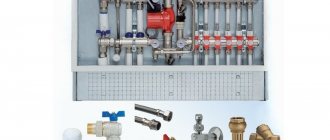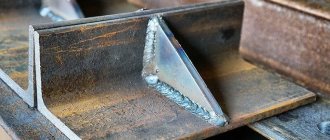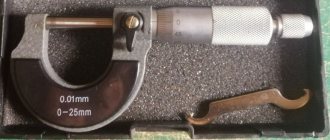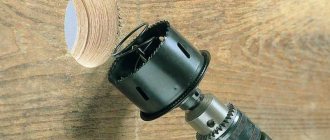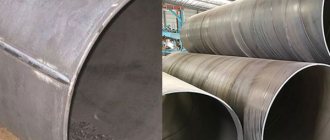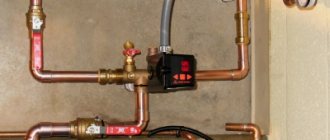Pipes made of stainless steel alloys are now actively used for the installation of heating, water supply and sewerage systems. By choosing the diameters of stainless steel pipes according to a special size table, you can successfully select such products to solve various problems.
For each type of stainless pipes there are maximum permissible deviations from the parameters defined by the relevant standards
All pipes for the production of which stainless steel is used are produced in strict accordance with the regulatory document. GOST stipulates not only the chemical composition of the material for their manufacture, but also their production technologies, sizes and assortment.
Areas of application
Where is profiled stainless steel used:
- Mechanical engineering and shipbuilding - mufflers for vehicles, hydraulic cylinders, outlet pipes of gas turbines and engines, parts of various shafts and valves, accessories for cars.
- Furniture production - legs, stands and frames of furniture.
- Construction - supports, posts, truss columns, chimneys, stairs and stair railings, frames for cornices and awnings.
- Food industry - processing plants (especially for chocolate, mayonnaise), grills, oven heat exchangers.
- Production of commercial equipment - shelving, equipment for bars, restaurants.
- Chemical and oil refining industries - installations for the production of alkalis, acids, ring collectors.
- Department of Housing and Utilities.
- Medicine - manufacturing of equipment, various implants.
Technical characteristics and properties
Parameters of stainless steel profile pipe:
- Type of rolled pipe profile.
- Geometric dimensions of width, height and length of a segment.
- Wall thickness.
- Weight of 1 linear meter.
- Steel grade and its characteristics.
For the production of profile stainless steel products, the grade of austenitic steel AISI 304 (Russian analogue 08Х18ХН10) is mainly used. This is an acid-resistant material, not subject to corrosion, and can withstand short-term temperatures up to +900 °C. The metal density is 7.9–7.93 g/cm2, the elastic modulus is 193–200 GPa, and the shear modulus is 86 GPa.
Life time
Stainless steel profile metal can be used for at least 50 years without losing its original properties.
Maximum pressure readings for pipes
Indications of the maximum pressure that stainless steel pipes can withstand at a temperature of 20 ° C in accordance with DIN 17457, 11850 standards
| Diameter | Wall thickness | Aisi 304-321 316 Ti kg/cm2 | Aisi 304L-316L kg/cm2 |
| 15 | 1 | 116 | 96 |
| 16 | 1 | 109 | 90 |
| 16 | 1,5 | 163 | 135 |
| 17,2 | 1,65 | 167 | 139 |
| 17,2 | 2 | 203 | 168 |
| 18 | 1 | 97 | 80 |
| 18 | 1,5 | 145 | 120 |
| 19,05 | 1 | 91 | 76 |
| 19,05 | 1,25 | 114 | 95 |
| 19,05 | 1,65 | 151 | 125 |
| 20 | 1 | 87 | 72 |
| 20 | 1,5 | 131 | 108 |
| 21,3 | 1,65 | 135 | 112 |
| 21,3 | 2 | 164 | 136 |
| 21,3 | 2,6 | 213 | 176 |
| 22 | 1 | 79 | 66 |
| 22 | 1,5 | 119 | 99 |
| 25,4 | 1 | 69 | 57 |
| 25,4 | 1,25 | 86 | 71 |
| 25,4 | 1,65 | 107 | 89 |
| 26,9 | 1,65 | 130 | 107 |
| 26,9 | 2 | 168 | 140 |
| 26,9 | 2,6 | 62 | 52 |
| 28 | 1 | 93 | 77 |
| 28 | 1,5 | 58 | 48 |
| 30 | 1 | 87 | 72 |
| 30 | 1,5 | 54 | 45 |
| 32 | 1,65 | 82 | 68 |
| 32 | 2 | 85 | 71 |
| 33,7 | 2,9 | 103 | 86 |
| 33,7 | 3,2 | 150 | 124 |
| 33,7 | 1 | 165 | 137 |
| 33,7 | 1,5 | 51 | 43 |
| 34 | 1 | 77 | 64 |
| 34 | 1,5 | 46 | 38 |
| 38 | 1 | 69 | 57 |
| 38 | 1,5 | 44 | 36 |
| 40 | 1 | 107 | 89 |
| 40 | 1,5 | 66 | 54 |
| 42,4 | 1,65 | 68 | 56 |
| 42,4 | 2 | 82 | 68 |
| 42,4 | 2,6 | 107 | 89 |
| 42,4 | 2,9 | 119 | 99 |
| 42,4 | 3,2 | 132 | 109 |
| 44,5 | 1,5 | 59 | 49 |
| 44,5 | 2 | 78 | 65 |
| 48,3 | 1,65 | 60 | 49 |
| 48,3 | 2 | 72 | 60 |
| 48,3 | 2,6 | 94 | 78 |
| 48,3 | 2,9 | 105 | 87 |
| 48,3 | 3,2 | 115 | 96 |
| 50 | 1,5 | 52 | 43 |
| 50 | 2 | 70 | 58 |
| 53 | 1,5 | 49 | 41 |
| 54 | 2 | 65 | 54 |
| 60,3 | 1,65 | 48 | 40 |
| 60,3 | 2 | 58 | 48 |
| 60,3 | 2,6 | 75 | 62 |
| 60,3 | 2,9 | 84 | 69 |
| 60,3 | 3,2 | 92 | 77 |
| 60,3 | 3.6 | 104 | 86 |
| 70 | 1,5 | 37 | 31 |
| 70 | 2 | 50 | 41 |
| 76,1 | 1,65 | 38 | 31 |
| 76,1 | 2 | 46 | 38 |
| 76,1 | 2,6 | 60 | 49 |
| 76,1 | 2,9 | 66 | 55 |
| 76,1 | 3,2 | 73 | 61 |
| 76,1 | 3,6 | 82 | 68 |
| 80 | 1,5 | 31 | 26 |
| 84 | 2 | 41 | 34 |
| 88,9 | 1,65 | 32 | 27 |
| 88,9 | 2 | 39 | 33 |
| 88,9 | 2,6 | 51 | 42 |
| 88,9 | 2,9 | 57 | 47 |
| 88,9 | 3,2 | 63 | 52 |
| 88,9 | 3,6 | 71 | 59 |
| 88,9 | 4 | 78 | 56 |
| 101,6 | 1,65 | 28 | 23 |
| 101,6 | 2 | 34 | 28 |
| 101,6 | 3 | 51 | 43 |
| 103 | 1,5 | 25 | 21 |
| 104 | 2 | 34 | 28 |
| 114,3 | 1,65 | 25 | 21 |
| 114,3 | 2, | 30 | 25 |
| 114,3 | 2,6 | 40 | 33 |
| 114,3 | 2,9 | 44 | 37 |
| 114,3 | 3,2 | 49 | 40 |
| 114,3 | 3,6 | 55 | 46 |
| 114,3 | 4 | 61 | 51 |
| 129 | 2 | 27 | 22 |
| 139,7 | 2 | 25 | 21 |
| 139,7 | 2,6 | 32 | 27 |
| 139,7 | 3 | 37 | 31 |
| 139,7 | 4 | 50 | 41 |
| 154 | 2 | 23 | 19 |
| 156 | 3 | 34 | 28 |
| 168,3 | 2 | 21 | 17 |
| 168,3 | 2,6 | 27 | 22 |
| 168,3 | 3 | 31 | 26 |
| 168,3 | 3,6 | 37 | 31 |
| 168,3 | 4 | 41 | 34 |
| 204 | 2 | 17 | 14 |
| 205 | 2,5 | 21 | 18 |
| 206 | 3 | 25 | 21 |
| 219,1 | 2 | 16 | 13 |
| 219,1 | 2,6 | 21 | 17 |
| 219,1 | 3 | 24 | 20 |
| 219,1 | 3,6 | 29 | 24 |
| 219,1 | 4 | 32 | 26 |
| 254 | 2 | 4 | 11 |
| 256 | Z | 20 | 17 |
| 273 | 2 | 13 | 11 |
| 273 | 2,6 | 17 | 14 |
| 273 | 3 | 19 | 16 |
| 273 | 3,6 | 23 | 19 |
| 273 | 4 | 26 | 21 |
How are they produced?
Profile pipes are made from stainless steel using two technologies:
- The finished product is formed from a blank in the form of a metal strip (strip).
- A round pipe is profiled.
Strip manufacturing technology
The method makes it possible to obtain a profile pipe made of stainless steel with a seam. Welding of sheet steel strips is carried out using high-frequency electric welding, laser or plasma welding in a conventional environment, as well as tungsten electrodes in inert gas (TIG welding). The production process itself is as follows:
- The strip is cut from stainless steel sheets on special rolling mills and fed into a sheet bending mill.
- The metal strip is formed on the rollers of a sheet bending mill into a round blank with open edges.
- The edges are welded using one of the selected types of welding. Excess metal (grant) is removed with cutters.
- The workpiece is calibrated on rollers to a given profile shape.
- The finished product is cut into pieces of the required length.
To relieve internal stress, the stainless steel profile pipe is subjected to heat treatment (annealing). The workpiece is heated to +550…650 °C for 60–90 minutes, followed by gradual cooling (tempering). As a result, it becomes stronger and more durable.
Profiling
This technology for the production of profile stainless pipes involves the use of seamless cold- and heat-deformed pipes of round cross-section as initial blanks. They acquire the desired profile shape when passing through calibrating rollers in a cold or heated state.
Next, the cold-deformed profile pipe is subjected to heat treatment. At the last stage, the rolled metal is cut into pieces and undergoes surface quality control, tensile tests, and geometric dimensions testing.
Regulations
Technical production conditions, chemical composition of raw materials, geometric parameters for each cross-sectional shape of profile stainless steel pipes are regulated by several regulatory documents (GOSTs).
Standards and GOSTs
Russian manufacturers producing profile pipe products made of corrosion-resistant steel, depending on the technology used, use the following standards:
- GOST 11068-81 - for electric-welded pipe products.
- GOST 9940-81 - for seamless pipes manufactured using the profiling method.
The range and standard sizes of profiled stainless steel pipes are established by the following regulatory documents:
- GOST 8639-82 - for square profile.
- GOST 8645-68, GOST 8645-78, GOST 8645-86 - rectangular section.
- GOST 8642-68 - for oval pipes.
Brands and guaranteed parameters
The tables contained in the regulatory documents for pipe products made from stainless steel contain various parameters. In particular, from these tables you can take information about the grades of steel used for the production of such pipes.
Permissible deviations from dimensions must be within the values specified in the table
Knowing the brand of material from which the pipe is made allows you to get an idea of which of its parameters are guaranteed. These include in particular:
- A – mechanical characteristics of the steel used;
- B – its chemical composition;
- B – the relationship between the chemical composition and mechanical properties of the alloy used.
Types, assortment: sizes and sections
There are different types of stainless steel profile pipes depending on the cross-sectional shape. She may be:
- Oval.
- Rectangular.
- Square.
- Flat oval.
- Drop-shaped.
- With hollow ribs.
Stainless steel pipes and other profile configurations are also produced: in the form of a trapezoid, rhombus, parallelogram, triangle, hexagon, etc. But they are mainly produced by foreign companies according to European or American standards.
The classification of profile pipes by type of surface treatment is as follows:
- Polished.
- Matte.
- Polished to a mirror finish.
Square
Square profiles are highly durable and reliable. Their advantage is the presence of four stiffening ribs, which increase resistance to bending loads. The production of pipes with a square profile and their assortment is regulated by GOST 8639-92, according to which the external dimensions of the edges range from 10 × 10 mm to 180 × 180 mm. The minimum wall thickness is 0.8 mm, the maximum is 14 mm. The length of the products can be:
- Unmeasured. Seamless hot-deformed - from 4 to 12.5 m, seamless cold-deformed and electric-welded - from 1.5 to 11 m.
- Measured. Seamless hot-deformed - from 4 to 12.5 m, seamless cold-deformed - 4.5–11 m, electric welded - from 5 to 9 m.
- Multiple measured. With an allowance for each cut of 5 mm.
Rectangular
Stainless steel pipes with rectangular profiles can withstand high loads, the same in magnitude as solid products. In addition, it is convenient for installation, transportation and storage. It is used in the construction industry and mechanical engineering for the manufacture of frame metal structures and support posts.
Standard profile dimensions for rectangular pipes are shown in the table.
| Section parameters, mm | Wall thickness, mm |
| 15×10; 20×10; 35×30; 60×20 | 2 |
| 20×15; 25×10; 25×15 | 2,5 |
| 30×10; 30×15; 30×20 | 3 |
| 35×15; 35×20; 35×25 | 3,5 |
| 40×15; 40×20; 40×25; 40×30; (42)x20; (42)x30; 45×20; 45×30; 50×25; 50×30; 50×35; 50×40; 80×50; 100×60 | 4 |
| 60×25; 60×30; 60×40 | 5 |
| 70×30; 70×40; 70×50 | 6 |
| 80×40; 80×60; 90×40; 90×60; 100×40; 100×50; 100×70; 110×40; 110×50; 110×60 | 7 |
| 120×40; 120×60; 120×80; 140×60; 140×80 | 8 |
| 140×120 | 9 |
| 150×80; 150×100 | 10 |
| 180×80; 180×100; 180×150 | 12 |
Regulatory documents provide for the possibility of producing stainless rectangular pipes with non-standard dimensions, for example, an extended range of wall thickness from 0.8 to 20 mm and edge sizes from 28 × 25 mm to 230 × 100 mm.
The length of the segments according to GOST 11068-81 is:
- Measured (5–9 m).
- Unmeasured (1.5–9 m).
- Multiple measurements (no more than 9 m with an allowance of 5 mm for each cut).
Matte
Profile pipes with a matte outer surface are used as structural elements, the decorative appearance of which does not require high requirements. For example, for installation:
- Production shelving.
- Work sites.
- Support structures, etc.
Sanded
Polished stainless steel profile pipes combine aesthetic appearance with high strength, wear resistance and durability. They have no planar or structural flaws; they are in demand in areas where impeccable smoothness of surfaces is required.
To process stainless steel profiles, 2 technologies are used:
- Electrochemical. The workpiece is immersed in a solution of concentrated acid. If the outer surface is polished, then the product is then surrounded by round electrodes. To treat the internal surface, the electrode is inserted into the cavity of the pipe. Electric current is then applied to them.
- Abrasive. For primary processing, coarse abrasives with a grain size of 180–320 microns are used; a polished surface is obtained by using abrasive materials with a finer grain size. For final polishing, felt sanding belts are used.
Stainless steel pipes with a polished surface are endowed with decorative qualities, therefore they are used for interior decoration, the manufacture of cabinet furniture elements, fences, and railings.
Pipe wall thickness: what is the importance of this parameter
The dimensions of the ribs of stainless steel profile pipes are important for assembling structures, but the strength characteristics of rolled metal and its load-bearing capacity depend only on the wall thickness. The larger it is, the more resistant the finished product is to various types of deformations and loads.
Standard sizes and markings
Marking of profile stainless steel products is applied to their outer side at the factory after manufacturing. It consists of information about the standard size of the product, as well as the steel grade and the manufacturer’s trademark.
For example, let’s decipher the marking 100×100x5 09G2S:
- The first two positions indicate the size of the ribs in mm. In this case, 100 mm and 100 mm, since the pipe has a square profile.
- The third is the thickness of the walls.
- The fourth is the steel grade (set if necessary).
Surface quality, finishing
The quality of the outer and inner surface is one of the most essential properties of pipe products, which determines the scope of its application, price, and production time. Welded pipes are made from cold-rolled or hot-rolled coils. For the needs of the food industry, at the final stage of production, pipes can be subjected to heat treatment (for example, bright annealing), chemical treatment (pickling) and mechanical treatment (grinding the internal surface to a surface finish of 0.5-0.8 microns in the area of the base material of the pipe and up to 1.6 microns in the area weld, grinding the outer surface to a cleanliness of less than 1.0 microns). For each method of using a pipe, an optimal list of finishing operations can be selected, which will provide the most complete set of useful properties of the pipe. For example, if when using welded pipes it is necessary to change their shape (bending, flattening, etc.), then it is recommended to order stainless steel pipes with heat treatment. The entire set of finishing operations is conventionally indicated in the markings, which must be applied to each pipe (see Table 1). An example of food grade welded stainless steel pipe marking is shown below:
MM 52x1 No.541854 1.4301 DIN 17457/11850 CC PK1,
where MM is the trademark of the plant, Italy; 52x1 – diameter (52) and wall thickness (1) of the pipe in mm; 1.4301 – designation of steel grade (AISI 304); DIN 17457/11850 - designation of the standards in accordance with which this pipe is produced, CC - designation of the quality of the pipe surface (according to DIN 17457 and DIN 11850):
The pipe is made of cold-rolled coil with improved surface quality; the seam is almost indistinguishable from the outside; the surfaces are etched. The inside of the pipe is pickled, ground to a surface finish of less than 0.8 m; the weld area is ground to a surface finish of less than 1.6 microns; the seam is laminated; RK1 – pipe tested in accordance with test class 1.
Table 2. Design and designation of types of surface treatment of welded stainless steel pipes for the food industry (DIN 11850).
| Production technology | Availability of heat treatment | Surface quality | Abbreviated version designation | Production technology |
| Welded according to DIN 17457 (Technical delivery conditions) | Heat treated | Smooth metal. The weld seam, starting from the nominal diameter DN 25, is flush with the walls; average roughness value Ra = 2.5 µm except for the weld zone | Smooth metal according to performance class “k 2” or “k 3” according to DIN 17 457 | VA |
| Not heat treated | Smooth metal according to performance class “k 0” or “k 1” according to DIN 17457 | SA | ||
| Heat treated | Sanded with 400 grit or polished | BB | ||
| Not heat treated | NE | |||
| Heat treated | Smooth metal. Average roughness Ra = 0.5 µm Weld area Ra = 1.6 µm | Smooth metal according to performance class “k3”, “l 1” or “l 2” according to DIN 17457 | Sun | |
| Not heat treated | Smooth metal according to performance class “k 0” or “k 1” according to DIN 17457 | SS | ||
| Heat treated | Sanded with 400 grit or polished | BD | ||
| Not heat treated | CD |
Advantages and disadvantages
Stainless steel profile pipes have the following qualities and advantages:
- High strength characteristics with low weight.
- Due to the flat edges, they are more convenient to install than round profile pipes.
- Resistant to temperature changes.
- The ability to withstand any type of load (transverse, tensile and torsional), since they are distributed to the walls at right angles.
- High corrosion resistance, long service life.
- Heat resistance.
- Good weldability.
- Aesthetic appearance.
- Wear resistance.
- Frost resistance.
- Completely inert to chemical influences.
The disadvantages of profile products include:
- Relatively high cost.
- Inability to use for water supply pipelines and heating system wiring.
Tips on how to choose
Stainless steel profile pipes should be selected taking into account operating conditions, based on the following indicators:
- Maximum load.
- Duration and intensity of mechanical, thermal and chemical influences.
Depending on these parameters, the technical characteristics of the products are selected:
- Steel grade.
- Profile shape and dimensions.
- Wall thickness.
- Production technology.
The quality of purchased stainless steel products must be confirmed by factory certificates.
Approximate price and best manufacturers
The price of a stainless steel profile pipe depends on the grade of material, length of the section, wall thickness, type of surface treatment and manufacturer. The volume of the supplied batch can influence the final cost of the product.
The price range is quite large. For example, the price of a matte stainless square profile pipe can range from 3 to 30 dollars per meter, while rectangular steel pipes range from 4.5 to 42 dollars per meter.
Thick-walled, thin-walled and other stainless steel pipes
Depending on the ratio of the outer diameter (Dn) to the wall thickness (s), the following types of stainless steel pipes are distinguished:
- thin-walled pipes with Dn/s from 12.5 to 40 and pipes with a diameter of 20 mm or less with a wall of 1.5 mm;
- thick-walled pipes with Dn/s from 6 to 12.5;
- especially thin-walled pipes Dn/s more than 40 and pipes with a diameter of 20 mm and a wall of 0.5 mm or less;
- especially thick-walled pipes with Dn/s less than 6.
Thick-walled pipes are manufactured by heat treatment. Thin-walled pipes are produced without heat treatment, in which the ratio of the outer diameter to the wall thickness is 50 or more. Thin-walled pipes are characterized by sufficient flexibility.
How to bend stainless pipes
When bending such products, it is important to prevent changes in the original cross-sectional configuration and the formation of creases on their inner surface. Deformation will weaken the load-bearing capacity of such a part, reduce its throughput, and increase the likelihood of corrosion.
In industrial conditions, bending of stainless steel pipes is carried out in the following ways:
- Run-in.
- Winding.
- Rolling.
- Drawing.
- Hydrostatic.
- By pushing.
- Using two supports.
Such pipe bending technologies allow you to obtain high-quality results, but require special equipment.
At home, you can bend a stainless steel profile using a manual pipe bender. In this case, to support the walls from the inside, the following is used:
- Clean dry sand and two plugs. First, one of the plugs is installed. Then the pipe at the future bend is filled with sand through the free end, carefully compacted and clogged with another plug. Next, the pipe is bent around a blank of the required size.
- A bundle of wire. The pipe cavity is filled to capacity with pieces of thick wire. After bending, the wire is removed one by one.
- A spring of the appropriate shape. It should be wound from wire 2–4 mm thick in such a shape that it fits freely into the cavity of the pipe at the bend. At the end of bending, the spring is removed using a wire previously left outside.
To bend a profile with a significant bending radius, the walls are preheated with a blowtorch or gas torch. Heated metal bends more easily.
Installation Tips
When assembling metal structures from stainless steel profile pipes, the parts are connected by welding or fastening with clamps. The elements can be fixed using electric arc, gas or resistance welding.
When arc welding, it is important to choose the right electrode. The quality of the weld depends on its diameter. If it is too thin, the welding process will be interrupted; if the electrode cross-section is too large, a thin-walled pipe can be burned.
Electric arc welding should not be performed in open areas. Such work is carried out in special premises. In this case, the ends of the parts to be welded must first be cleaned and degreased.
The contact type of welding forms a welding seam of increased reliability. There are no restrictions on ambient temperature and other weather conditions for its use.
General recommendations for carrying out any type of welding are as follows:
- When choosing a welding temperature, you should proceed from the thickness of the metal, since profile products are more susceptible to deformation than round ones.
- To maintain the internal clearance of the profile, it is necessary to prevent molten metal from entering the stainless steel profile pipe.
- When performing welding, it is necessary to carefully check the geometric coincidence of the ends of the parts being welded so that distortions do not occur in the metal structure.
Alternative to profile pipes
The use of profile stainless pipes is not always technically and economically feasible. It's not cheap. In addition, it cannot be used for laying pipelines transporting liquid and gaseous media under high pressure. This is especially true for electric-welded products with a seam: due to the presence of different angles inside such pipelines, blockages can quickly form at the bends. For the installation of such communications, only round pipes are used. And it doesn't have to be stainless steel.
Modern pipe products made of reinforced polypropylene are not inferior in a number of technical characteristics to stainless steel, but are much cheaper. Profiles made of plastic are more often used as ventilation ducts. They are available in white, so they fit more harmoniously into the interior of kitchens and bathrooms.
An alternative option for constructing a chimney could be a galvanized sandwich pipe. Galvanized steel is just as fire-resistant and fireproof as stainless steel, but is less resistant to corrosion from condensation. But the price of galvanized sandwich chimneys is much lower, as is the cost of installation. And in order to slow down the corrosive destruction of the metal, the surfaces of the chimney are coated with a special heat-resistant paint for galvanizing.
Aluminum pipes are also of good quality. They are lightweight, corrosion-resistant, and are a good option for making indoor decorative elements, furniture parts and other lightly loaded structures.
Principles of designation of stainless steels in Russia and CIS countries
Stainless steels in Russia and the CIS countries, as mentioned above, are marked using a combination of alphabetic and digital symbols. In this case, the former indicate what chemical elements are contained in the steel, as well as the methods of its smelting, and from the numbers one can determine the quantitative content of the elements listed in the designation of stainless steel.
All letter designations of chemical elements used in marking stainless steels are unified and can be used to unambiguously determine the composition of stainless steel.
Thus, the standard, the basis of which was the Soviet GOST, stipulates the following letter designations of chemical elements:
- C – silicon, which is introduced into the composition of stainless steel so that a layer of scale does not form on the surface of products made from it after heat treatment;
- Yu - aluminum, with the help of which they achieve stabilization of the structure of stainless steel, and also reduce the risk of the formation of foreign inclusions in the structure of the alloy, which can occur at the moment when products made from it come into contact with boiling liquids;
- X – chromium, which is the main alloying element of all stainless steel alloys and gives them exceptional corrosion resistance, for which they are valued;
- M – molybdenum, which imparts stability to the structure of stainless steels during their interaction with aggressive gas environments;
- E – selenium, which provides stainless steel products with the required electrical resistance parameters;
- P – boron, which increases the corrosion resistance of steels when exposed to chemical environments and high temperatures;
- K – cobalt, used to stabilize the carbon contained in steel;
- P – phosphorus, used in steel as a corrosion passivator;
- B – niobium, which is introduced into the composition of stainless steel in order to activate ferritic processes occurring in the crystals of the internal structure of the metal;
- F – vanadium, added to stainless steel to increase its ductility.
Additional letters in the marking of high-quality steels
Naturally, this is not the entire list of chemical elements that may be contained in stainless steel. Like any other steel, a stainless alloy necessarily contains carbon (the letter “U” in the marking), which not only gives it the required strength characteristics, but also increases its resistance to oxidative processes. To give stainless steel good malleability and increase its resistance to high temperatures, nickel is added to it, which is designated by the letter “N” in the alloy markings.
Despite the fact that stainless steels are already highly corrosion resistant, the degree of such protection can be increased by adding copper to their composition, designated in the marking by the letter “D”. In addition to the listed elements, stainless steels may contain manganese (letter “G”), titanium (“T”), zirconium (“C”) and tungsten (“B”).
Features of operation
Structures made from profile stainless steel pipes do not lose their load-bearing capacity and presentable appearance over time. They do not need painting and can be easily washed with household chemicals that do not contain chlorine. Dried stains cannot be scraped off or removed with a wire brush: use only a soft cloth or foam sponges.
Possible problems
In some cases, rolled stainless steel may be subject to corrosion. Foci of rust appear on the walls of products after prolonged contact with a concentrated chlorine solution. To eliminate the cause of corrosion, it is necessary to thoroughly rinse off the chlorine-rich liquid. The rusting process of stainless steel parts will slow down, and they will retain their anti-corrosion properties.
Packaging, transportation and storage
For ease of transportation, profiled stainless steel pipes are bundled or tightly placed in wooden containers lined with waterproof paper. The packages are tied with wire or metal tape in three or four places depending on the weight. For strapping during loading and unloading operations, bags and containers are equipped with special clamps.
They can be transported by any type of transport. The packages are placed on the floor of the car or in the body of the car in stacks, separating the rows with spacers.
Profile stainless steel products are stored on racks in closed warehouses or under a canopy, where they will be protected from atmospheric moisture.


